OCIEPKA TIMELINE
1891 (April 24): Teofil Ociepka was born in Janów, in the region of Upper Silesia, present-day district of Katowice, Poland.
1905: Ociepka’s father died, and Teofil began working as a machinist in a coal mine. Later, he was employed in railways, where he worked until 1914.
1914–1918: Ociepka was drafted into the German Army and took part in combat during World War I. During the war, he became interested in esotericism and encountered the book 72 Names of God, the Polish translation of Oedipus Aegyptiacus by Athanasius Kircher.
1919–1921: Ociepka took part in the Silesian Uprisings against German rule. After the war, Ociepka came into contact with Philip Hohmann from Wittenberg, who later became his spiritual teacher.
Early 1920s: An esoteric circle centered around Ociepka began to form.
1927: Ociepka created his first paintings, with, as he believed, a spiritual inspiration from Hohmann. The period of “morality works” began.
1930: Criticized by a director of the Silesian Museum, Ociepka abandoned his artistic work, and only returned to it shortly before World War II.
Before 1939: With Hohmann’s help, Ociepka became a corresponding member of the German Section [Deutsche Abteilung] of the Rosicrucian Fellowship.
1945: Ociepka corresponded with the headquarters of the Rosicrucian Fellowship in Oceanside, California.
Ca. 1946: A circle of painters was established at the Coal Mine “Wieczorek” (where Ociepka worked, until his retirement, as an over-ground worker), later named by scholars Janowska Group, Janowska Occult Community, or the Circle of Unprofessional Painters. Ociepka remained a member until 1959, when he left Silesia.
1948: Izabela “Czajka” Stachowicz organized an individual exhibition of Ociepka’s paintings, promoting the artist as the “Polish Henri Rousseau.” During this time, Ociepka was painting, among other topics, spiritual beings from Silesian folklore, in works such as Utopiec (1948).
1950s: Ociepka created a series of well-known paintings based on a book by the nineteenth century German mystic, Jakob Lorber: Saturn: A Description of the Planet Together with Its Rings and Moons, and Its Living Beings. Among those works, there were Lion of Saturn (1954), Blue Bear of Saturn (1954), Flying Cow of Saturn (1956), and others.
1959: Ociepka married Julia Ufnal.
1960: Ociepka painted one of his Self-portraits, visualizing himself in the company of fantastic spiritual creatures.
1962: Eye of Providence, a painting connected to the artist’s interest in Rosicrucianism, was created.
1963: Living Fire, a painting inspired among others by alchemy, was created.
1969: Because of problems in his local environment, Ociepka moved out of Janów to Bydgoszcz, the hometown of his wife.
1976: Ociepka was decorated with the Order of Polonia Restituta.
1978 (January 15): Ociepka died in Bydgoszcz, Poland. A street in the city bears his name.
BIOGRAPHY
Teofil Ociepka [Image at right] was a charismatic figure, an 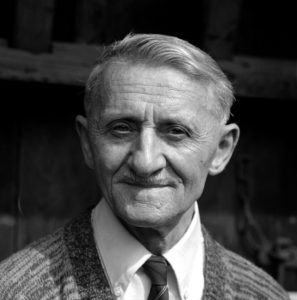 esoteric teacher and the first leader of the occult circle of unprofessional painters called the Janowska Group. He worked as an over-ground coal mine worker in the area of Upper Silesia, at the Polish–German border. He is one of the most interesting Polish unprofessional painters, and one of the most intriguing Polish esotericists, whose works were inspired by Rosicrucianism, Christian mysticism, Theosophy, and twentieth century occult currents, and whose works presented both what he called his “morality” and his esoteric teachings.
esoteric teacher and the first leader of the occult circle of unprofessional painters called the Janowska Group. He worked as an over-ground coal mine worker in the area of Upper Silesia, at the Polish–German border. He is one of the most interesting Polish unprofessional painters, and one of the most intriguing Polish esotericists, whose works were inspired by Rosicrucianism, Christian mysticism, Theosophy, and twentieth century occult currents, and whose works presented both what he called his “morality” and his esoteric teachings.
Teofil Ociepka was born on April 24, 1891 in Janów (Ociepka 1919:1). The early death of his father forced Teofil to start working as a machinist in a mine when he was fourteen. He fought in World War I in the German Army, and after that he took part in the Silesian Uprisings against German rule from 1919 to 1921 (Ociepka 1919). Having grown up in Silesia, Ociepka spoke Polish and German, but he was also semi-fluent in French. Since the war years, Ociepka became interested in Western Esotericism, particularly after he found a book of Athanasius Kircher (1602-1680), Oedipus Aegyptiacus (1652–1654), in the Polish translation called 72 names of God (Jackowski 1984:38). Looking for another esoteric book in Germany, he came into contact with Philip Hohmann, an esoteric writer and an enigmatic figure from Wittenberg, who became a very important influence in Ociepka’s life. According to Ociepka, they exchanged letters for the next forty years (Wisłocki 2010:43). Hohmann became his spiritual teacher, and sent him esoteric books and sets of spiritual exercises which were “to help Ociepka in gaining an internal power, which could enable him to rule over natural processes….” (Jackowski 1984:37-56).
One of the most interesting esoteric-related moments in Teofil Ociepka’s life was his awakening as a painter. Ociepka believed that it was Hohmann who made him an artist with a spiritual purpose. He claimed: “[Hohmann] wrote to me: ‘Teofil, a spirit will come to you and will teach you how to paint.’ I have never seen any spirit, but something 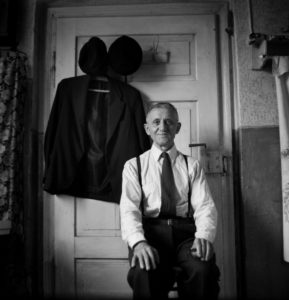 undefined was born in my soul, which could be called love for the essence of beauty, that is for God. That was in 1927 and, from that time on, I began to paint and have been painting ever since with unfaltering joy and pleasure.” (Wisłocki 2010:43). [Image at right]
undefined was born in my soul, which could be called love for the essence of beauty, that is for God. That was in 1927 and, from that time on, I began to paint and have been painting ever since with unfaltering joy and pleasure.” (Wisłocki 2010:43). [Image at right]
Besides those occult experiences, there is no doubt that Philip Hohmann had a great impact on the painter’s intellectual formation, as well as on his esoteric interests. It was most probably with his support that (sometime before 1939) Ociepka became a corresponding member of a Rosicrucian circle. It was the German Section of the Rosicrucian Fellowship: An International Association of Christian Mystics, based in Oceanside, California, and founded by Max Heindel (pseud. of Carl Louis von Grasshoff, 1865-1919; for more see Faivre 1994:91, and Goodrick-Clarke 2008:127). Heindel’s teachings were inspired by Rudolf Steiner (1861–1925) (see Weber 2005); he had also been connected to the Theosophical Society as the vice-president of a branch in Los Angeles, California from 1904 to 1905 (Heindel 2012:6). During World War II, Ociepka lost contact with the organization, but immediately after its end he was reinstated as a corresponding member (Wisłocki 2007:202-04).
Teofil Ociepka was familiar with occult milieus in Poland; he collected most esoteric journals in the interwar period. He gathered many books related to esotericism, mostly in German and Polish. After World War II, Ociepka’s library was one of the largest esoteric collections in Poland (Prokopiuk 2010:125).
Ociepka wanted to share his knowledge of esotericism. He lent out his books, and he was actively looking for students, even making advertisements in press. Eventually, he gathered a circle around himself, including Bolesław Skulik, Walter Goj and many others (Wisłocki 2010:20). In the mid-1950s, Ociepka was inspired by a book by an Austrian Christian mystic and visionary, Jakob Lorber (1800-1864), Saturn: A Description of the Planet Together with Its Rings and Moons, and Its Living Beings (Lorber [1841] 1969), and he created probably the best-known series of his paintings. Saturn played an important role not only in Lorber’s book, but also in the writings of Heindel (Heindel 1909:205-06), which explains its special role for Ociepka too. The painter believed that a person’s astral body, both 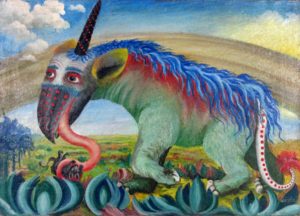 before birth and after death on Earth, exist on Saturn (Wisłocki 1984:62). Among the works belonging to Ociepka’s Saturn cycle, we can find paintings such as Lion of Saturn (1954), [Image at right] Blue Bear of Saturn (1954), and Flying Cow of Saturn (1956). It is important to note that, even if Ociepka’s paintings could appear as mere illustrations of Lorber’s detailed descriptions, in this series of paintings, as well as in others, Ociepka added some details and colors with a specific esoteric meaning (cf. Hess and Dulska 2016:68-71). He wrote a booklet called “Dialectical Religionism,” where he explained the use of symbolism; Unfortunately, the essay was never published and, if it still exists, it is not available to scholars (cf. Jackowski 1984:45, 54-55).
before birth and after death on Earth, exist on Saturn (Wisłocki 1984:62). Among the works belonging to Ociepka’s Saturn cycle, we can find paintings such as Lion of Saturn (1954), [Image at right] Blue Bear of Saturn (1954), and Flying Cow of Saturn (1956). It is important to note that, even if Ociepka’s paintings could appear as mere illustrations of Lorber’s detailed descriptions, in this series of paintings, as well as in others, Ociepka added some details and colors with a specific esoteric meaning (cf. Hess and Dulska 2016:68-71). He wrote a booklet called “Dialectical Religionism,” where he explained the use of symbolism; Unfortunately, the essay was never published and, if it still exists, it is not available to scholars (cf. Jackowski 1984:45, 54-55).
In Poland after World War II (under the Communist regime), the political situation strongly influenced art. The official materialistic philosophy denied any place to spiritual realities in works of art. Ociepka’s infernal-like dragons were rather interpreted as Paleozoic creatures, and other spiritual beings were treated as depictions 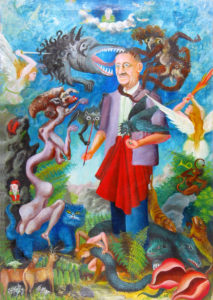 of local Silesian legends to comply with the political guidelines. Communist authorities were interested in topics related to regional traditions of the working-class coal miners. Izabela “Czajka” Stachowicz (1893-1969), one of the official patrons of the arts, had influence on Ociepka from the late 1940s on. Many misunderstandings surrounded the author in this time: to promote Ociepka’s work, his biography was falsified, and he was presented as an underground miner who painted Silesian folklore (Wisłocki 1984:62-64), or a Polish equivalent of Henri Rousseau (1844-1910).
of local Silesian legends to comply with the political guidelines. Communist authorities were interested in topics related to regional traditions of the working-class coal miners. Izabela “Czajka” Stachowicz (1893-1969), one of the official patrons of the arts, had influence on Ociepka from the late 1940s on. Many misunderstandings surrounded the author in this time: to promote Ociepka’s work, his biography was falsified, and he was presented as an underground miner who painted Silesian folklore (Wisłocki 1984:62-64), or a Polish equivalent of Henri Rousseau (1844-1910).
In fact, Ociepka gladly painted more and more folklore-related paintings, believing that the beings of legendsare part of an unknown, alternative reality that is not available to everyone, but intrudes into our world in various ways. He depicted many folklore-related beings in works like Utopiec (1948) and Silesia-related element, such as Miner in the Forest (1956). In 1960, he painted one of his Self-portraits, visualizing himself in the company of fantastic spiritual creatures. [Image at right] Ociepka’s worldview combined elements of Catholicism and Silesian folklore, but his main interests were in esoteric traditions and concentrated on Rosicrucianism, Theosophy, Anthroposophy, Astrology, Kabbalah, Magic and Alchemy. This can be seen in his works (Hess and Dulska 2016:73).
In this complex situation, Ociepka still promoted his spiritual-related 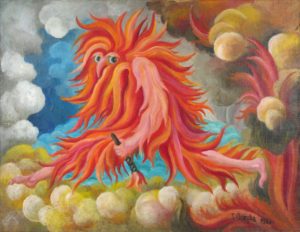 works, even when they were officially interpreted as something else. In 1963, for example, he created Living Fire, a painting inspired among others by alchemy. [Image at right] He became quite popular, which unfortunately provoked his colleagues’ envy. Anonymous letters of accusation were written to the authorities, and the atmosphere around the painter became so bad that he decided to move to a different part of Poland, to Bydgoszcz, in 1969 (Fiderkiewicz 1994:35). Today there is a street in the city named after him. Ociepka was decorated with the Order of Polonia Restituta when he was eighty-five.
works, even when they were officially interpreted as something else. In 1963, for example, he created Living Fire, a painting inspired among others by alchemy. [Image at right] He became quite popular, which unfortunately provoked his colleagues’ envy. Anonymous letters of accusation were written to the authorities, and the atmosphere around the painter became so bad that he decided to move to a different part of Poland, to Bydgoszcz, in 1969 (Fiderkiewicz 1994:35). Today there is a street in the city named after him. Ociepka was decorated with the Order of Polonia Restituta when he was eighty-five.
Teofil Ociepka died on January 15, 1978. His life become a subject of interest to ethnologists and art historians. The activities of his occult circle of painters were poetically illustrated in a movie directed by Lech Majewski, titled Angelus.
IMAGES
Image #1: Teofil Ociepka. 1962/63. Photo by Eustachy Kossakowski. Copyright Anka Ptaszkowska. Courtesy of the Museum of Modern Art in Warsaw.
Image #2: Teofil Ociepka. 1962/1963. Photo by Eustachy Kossakowski. Copyright Anka Ptaszkowska. Courtesy of the Museum of Modern Art in Warsaw.
Image #3: Teofil Ociepka, Lion of Saturn [Lew Saturna], 1954. Courtesy of National Museum of Ethnography in Warsaw.
Image #4: Teofil Ociepka, Self-portrait [Autoportret], 1960. Courtesy of National Museum of Ethnography in Warsaw.
Image #5: Teofil Ociepka, Living Fire [Żywy Ogień], 1963. Courtesy of National Museum of Ethnography in Warsaw.
REFERENCES
Angelus [movie]. 2000. Directed by Lech Majewski. Warsaw: WFDiF.
Faivre, Antoine. 1994. Access to Western Esotericism. New York: State University of New York Press.
Fiderkiewicz, Maria. 1994. Śląscy “pariasi” pędzla i dłuta (1945–1993). Katowice: Muzeum Śląskie.
Goodrick-Clarke, Nicholas. 2008. The Western Esoteric Traditions: A Historical Introduction. New York: Oxford University Press.
Heindel, Max. 2012. Birth of the Rosicrucian Fellowship: The History of Its Inception. Oceanside, CA: Rosicrucian Fellowship.
Hess, Karolina M., and Małgorzata A. Dulska. 2016. “Rose Cross, Saturn’s Menagerie and the Coal Mines of Silesia: Strange Visions of Teofil Ociepka.” Nova Religio: The Journal of Alternative and Emergent Religions 19:57–79.
Jackowski, Aleksander. 1984. “Teofil Ociepka.” Polska Sztuka Ludowa 1-2, n.38, 37–56.
Kitowska-Łysiak, Małgorzata. 2007. ‘‘Teofil Ociepka,’’ Instytut Historii Sztuki KUL, November 2007. Accessed from culture.pl/pl/tworca/teofil-ociepka on 31 May 2017.
Lorber, Jakob. [1841] 1969. Der Saturn. Darstellung dieses Planeten samt Ring und Monden und seiner Lebewesen. Fourth Edition. Bietigheim (Württemberg): Lorber-Verlag.
Ociepka, Teofil. 1919. “Mój życiorys. Sosnowiec, 10 October 1919.” A single-page document 8-011-283 in the Zasoby archiwalne Powstań Śląskich (1919–1921), Józef Piłsudski Institute of America for Research in the Modern History of Poland, New York.
Prokopiuk, Jerzy. 2010. “Wśród książek pana Teofila. Eine Stichprobe.” Pp. 123–30 in Wisłocki 1984.
“Uczniowie.” Polska Sztuka Ludowa, 1–2, 38.
Weber, Charles. 2005. “The Heindel-Steiner Connection.” Accessed from members.shaw.ca/rosecross713/ Heindel-Steiner.htm on 31 May 2017.
Wilk, Sonia. ‘‘Grupa Janowska’’ [The Janowska Group], Miejski Dom Kultury ‘‘Szopienice– Giszowiec’’ w Katowicach. Accessed from mdk.katowice.pl/grupa-janowska# on 31 May 2017.
Wisłocki, Seweryn A. 1984. “W kręgu okultystów Janowa – Teofil Ociepka i jego uczniowie.” Polska Sztuka Ludowa 1-2, n.38, 57-64.
Wisłocki, Seweryn A. 2007. Janowscy “kapłani wiedzy tajemnej”. Okultyści, wizjonerzy i mistrzowie małej ojczyzny. Katowice: Wydawnictwo Naukowe “Śląsk”.
Wisłocki, Seweryn A. 2010. Mistrz Teofil Ociepka. Między władzą a prawdą. Katowice: Wydawnictwo Naukowe “Śląsk”.
Post Date:
9 June 2017
